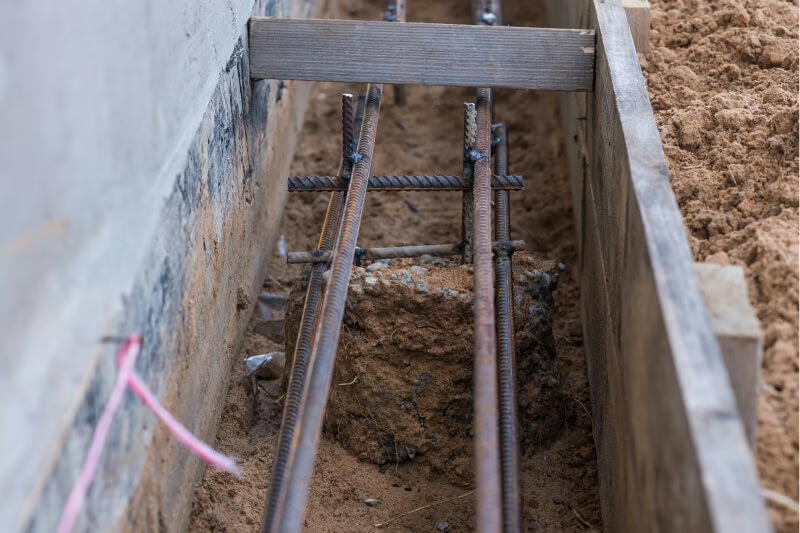What is underpinning? A guide to foundation repair and property stability
Posted 19 Sep 2025
Cracks in walls, dropped floors or doors and windows that no longer open or close properly can be signs of problems with existing foundations. This guide explains underpinning, its necessity, and how it can help ensure your home’s stability, for new builds and existing structures.
What is underpinning and why is it necessary?
Underpinning is the process of extending the foundation depth in sound soils. Reaching sound soils enables structural integrity, protecting your property from movement, tree roots or poor drainage.
The importance of foundation stability
Structural buildings rely on sound foundation for performance and longevity. Changes in soil conditions may cause the structure to settle, leading to building defects, safety risks, which in turn can significantly reduce the property value. This means it’s just as important to maintain your foundation and soil stability as it is to get it right in the first place, if you want your home to stay safe and sound for the long-term.
The signs that unpinning may be required
Here are a few things to look out for that may be signs that a property has settled and may need underpinning:
- Cracks in walls: Usually quite large and in a diagonal direction
- Sticking doors and windows: If they become tricky to open and close this could be a sign that the foundations have shifted.
- Sloping floors: Settling of foundations may cause the floor to become uneven with random dips.
- Gaps between skirting and coving to wall: If you notice that your skirting boards, cornicing or coving is separating this could indicate moving walls.
- Outside signs: Cracks in external brickwork or leaning chimneys are another sign.
Why do foundations settle?
The ground is everchanging and what often happens is that the soil under a foundation changes volume, most often shrinking, and this causes uneven settlement. Over time this ground change and movement can cause a structure to shift, and you’ll start to notice that doors and windows stick, cracks appear, all signs that stability is compromised. Here’s some common causes of soil changes:
- Soil Shrinkability: Soll movement can lead to uneven settling.
- Trees & Hedges: Renowned for causing soil to shrink, leading to uneven settling and underpinning.
- Water leaks & drainage issues: Water problems in the ground can weaken support.
- Geological factors: Conditions such as old mining areas create unstable ground for foundations.
How to prevent movement to your foundations
There are steps you can take to proactively look after your foundations and reduce the risk of problems:
- Regular inspections: Check for all the signs mentioned above – uneven floors, sticking doors, cracks etc.
- Tree maintenance: Ideally, keep trees away from your house and those that are close by, keep them to a low height.
- Maintain drainage: Keep your gutters and downpipes in working order, as well as drains in the ground.
Underpinning methods overview
Underpinning into sound soil is key for stable foundations and choosing the right method will optimise the structural performance and long-term stability. There are two key methods:
- Mass concrete underpinning: Simple and most cost-effective, but labour-intensive.
- Piled/mini piled underpinning: Ideal for deep or unstable soil. More complex but avoids very deep excavations.
What to do if you suspect underpinning may be required
If you suspect that underpinning may be required to achieve stable foundations, then the best qualified person to ask about how to underpin a house is a structural engineer. They will assess the situation, and guide you through the process:
- Professional assessment: If you are suspicious of soil instability or building subsidence you must contact a structural engineer.
- Diagnosis: Having assessed the situation and a need for action, your structural engineer will recommend a solution, which may include underpinning and will require further intrusive investigations.
- Design & Building Control: if underpinning is required you will need to seek approval from your local authority.
- Contractor selection: You’ll then have to find someone to do the job. It’s always worth getting at least three quotes from qualified underpinning specialists. Your structural engineer may be able to recommend someone.
- Execution of work: Once approved, the underpinning work begins.
- Completion: when the work is signed off the contractor will provide you with a warranty, and your local authority will issue a completion certificate.
How much does underpinning a house cost?
Underpinning isn’t cheap so understanding the underpinning cost and regulations is crucial for making an informed, realistic decision. The underpinning method is the first cost consideration along with the severity of the issue and the required depth of support needed. Some underpinning requirements can be covered by buildings insurance so it’s worth checking your policy to see if a claim is possible and potential excess.
Selling an underpinned house
A correctly underpinned house with proper documentation should not put off potential buyers. If you are selling a home that’s undergone underpinning property work, it’s essential to be transparent with potential buyers, showing all structural reports and warranties to reassure them and any mortgage lenders that the property is stable and a safe investment.
Conclusion: your path forward
Like most things, early detection and action prevents bigger problems. Get in touch with DSA and we’ll guide you through the process, ensuring your home’s stability, safety, and long-term value.




